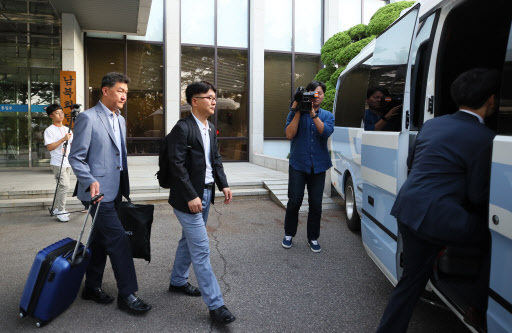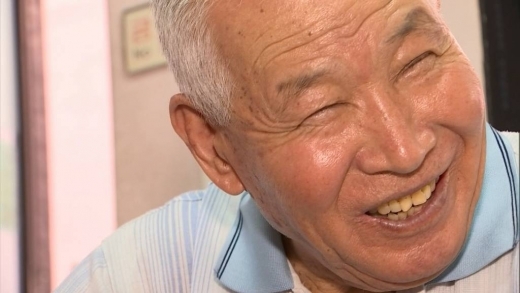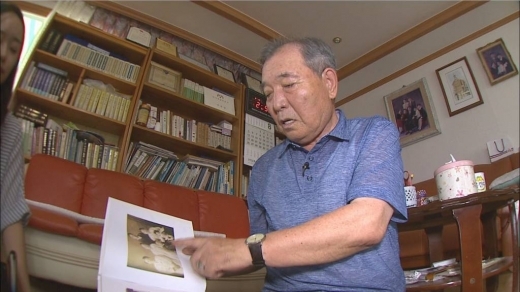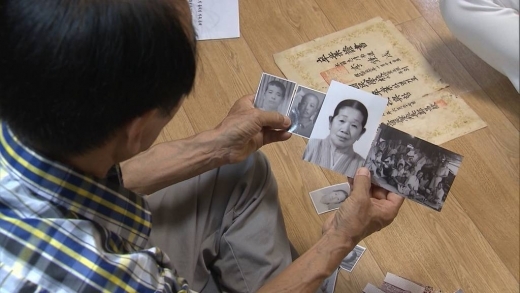A South Korean advance team left for North Korea on Wednesday to check on preparations for next week’s reunion event of families separated by the 1950-53 Korean War.
The 18-member team, led by Lee Jong-chol, a Red Cross official, departed for Kumgangsan on the North’s east coast, where the first reunion event in nearly three years will be held from Aug. 20-26, according to the Unification Ministry.
The team will inspect facilities, including accommodations and a banquet hall, and consult with North Korea to finalize details of the event. The delegation will stay there until the end of the reunion event.
The 18-member team, led by Lee Jong-chol, a Red Cross official, departed for Kumgangsan on the North’s east coast, where the first reunion event in nearly three years will be held from Aug. 20-26, according to the Unification Ministry.
The team will inspect facilities, including accommodations and a banquet hall, and consult with North Korea to finalize details of the event. The delegation will stay there until the end of the reunion event.

Families in South Korea
For the two rounds of reunion events to be held from Aug. 20-22 and Aug. 24-25, only 93 South Koreans and 88 North Koreans have been selected.
After 68 years of separation, Hwang Woo-seok, 89, is finally going to meet his daughter and granddaughter from the North at the event. When he was separated from his daughter, she was only 3 years old. He does not really remember what she looked like.
“I am really sorry (to my daughter.) (My) father was the only man (left for her in the family,) but he died at the age of 60,” he said. “She must have had suffered a lot, been lonely and had a lot of difficulties.”

Hwang left his home in Yeonbaek in North Korea in 1951 to avoid being taken away by North Korean troops. It was supposed to be only for three months. He never imagined it would separate him from his daughter for this long.
“I feel rewarded for having lived this long (that I can finally meet her),” he said. “I want to say thanks to my daughter for still being alive and being able to meet me.”
Many of the separated families have little shared memories as they have been divided across the border with limited or no contact since the war ended with an armistice in 1953.
Hwang is only one of the 57,000 people still hoping to meet their family members in the North. The government selected a total of 500 applicants through a computer lottery and then drew up the final list based on factors including age and family backgrounds.
The clock is ticking as families separated by the war are rapidly aging. If he had been chosen for a family reunion visit a decade ago, Hwang -- who has filed applications for inter-Korean reunion events for the past 30 years -- said he could have met all of his three sisters.
According to data from the Unification Ministry as of July, 132,603 citizens have been registered with the government since 1988. Of them, 75,741 have died, with 62 percent of the survivors aged 80 or older.
“I feel rewarded for having lived this long (that I can finally meet her),” he said. “I want to say thanks to my daughter for still being alive and being able to meet me.”
Many of the separated families have little shared memories as they have been divided across the border with limited or no contact since the war ended with an armistice in 1953.
Hwang is only one of the 57,000 people still hoping to meet their family members in the North. The government selected a total of 500 applicants through a computer lottery and then drew up the final list based on factors including age and family backgrounds.
The clock is ticking as families separated by the war are rapidly aging. If he had been chosen for a family reunion visit a decade ago, Hwang -- who has filed applications for inter-Korean reunion events for the past 30 years -- said he could have met all of his three sisters.
According to data from the Unification Ministry as of July, 132,603 citizens have been registered with the government since 1988. Of them, 75,741 have died, with 62 percent of the survivors aged 80 or older.

Park Gi-dong, 82, considers himself lucky to be able to be reunited with his sister, 73, and brother, 68, albeit briefly.
“I still wonder whether it is a dream or reality. I have never had this kind of overwhelming feeling in my life,” he said.
“After the cease-fire, we could not contact each other at all and I was blocked from news about them,” he said. “When I was split from my siblings, they were 6 and 2, respectively. Honestly, I remember only their names.
When the Korean War broke out, his family fled to Ganghwa in the South. His mother and siblings traveled back to their hometown in Yeonbaek in search of food, but never came back.
“I remember I had strolled around the neighborhood while holding my sister’s hands. She looked like a western person, not like my brothers. I remember we used to tease her by calling her a girl from Soviet Union,” he said.
The first thing he wants to ask his siblings is when their parents died and where they are buried.
Park has prepared a lot of daily supplies, such as underwear, socks, toothpaste, toothbrushes and soap gifts, for his family members, and also bought winter jumpers for them to keep warm in winter.
“I still wonder whether it is a dream or reality. I have never had this kind of overwhelming feeling in my life,” he said.
“After the cease-fire, we could not contact each other at all and I was blocked from news about them,” he said. “When I was split from my siblings, they were 6 and 2, respectively. Honestly, I remember only their names.
When the Korean War broke out, his family fled to Ganghwa in the South. His mother and siblings traveled back to their hometown in Yeonbaek in search of food, but never came back.
“I remember I had strolled around the neighborhood while holding my sister’s hands. She looked like a western person, not like my brothers. I remember we used to tease her by calling her a girl from Soviet Union,” he said.
The first thing he wants to ask his siblings is when their parents died and where they are buried.
Park has prepared a lot of daily supplies, such as underwear, socks, toothpaste, toothbrushes and soap gifts, for his family members, and also bought winter jumpers for them to keep warm in winter.

Lee Soo-nam, 77, could barely believe it when he heard his long-lost eldest brother was alive and he had been chosen for the reunion event. Lee, along with his 82-year-old elder brother, will finally meet their brother Jong-seong next week.
Lee, the youngest in his family, was living in Seoul in 1950. That year, his elder brother, then 19, was taken away by North Korean troops that were occupying Seoul and indiscriminately recruiting young men.
“He was very calm and gentle,” he recalled. “Well, I cannot imagine how he has aged. I just hope he is healthy.”
“My parents would have been really happy had they remained alive to hear this news,” he said. “I feel really sorry for my brother who has had to endure living all alone after losing his family and everything.”
“I want to say to him that it is my honor that he is alive, and I want to thank him.”
Lee feels sad that the short reunion could be his last chance to see his brother.
“I think it could be the last time we can see him,” he said. “There would be nothing better than if we had a permanent meeting station or something. The government will continue (these reunion efforts), and I think it should. That is my hope.”
The upcoming family reunion event, which had been halted since 2015 amid growing tensions over North Korea’s nuclear and missile tests, is a result of the Panmunjom Declaration signed by South Korean President Moon Jae-in and North Korean leader Kim Jong-un at their April 27 summit.
Since the two Koreas held the first reunion event in 2000 following a historic first inter-Korean summit, the reunions were held every year until 2015, except for 2008, 2011, 2012 and 2013 under two consecutive governments.
(laeticia.ock@heraldcorp.com)
-
Articles by Ock Hyun-ju






![[From the Scene] Monks, Buddhists hail return of remains of Buddhas](http://res.heraldm.com/phpwas/restmb_idxmake.php?idx=644&simg=/content/image/2024/04/19/20240419050617_0.jpg&u=20240419175937)








![[From the Scene] Monks, Buddhists hail return of remains of Buddhas](http://res.heraldm.com/phpwas/restmb_idxmake.php?idx=652&simg=/content/image/2024/04/19/20240419050617_0.jpg&u=20240419175937)

![[KH Explains] Hyundai's full hybrid edge to pay off amid slow transition to pure EVs](http://res.heraldm.com/phpwas/restmb_idxmake.php?idx=652&simg=/content/image/2024/04/18/20240418050645_0.jpg&u=20240419100350)

![[Today’s K-pop] Illit drops debut single remix](http://res.heraldm.com/phpwas/restmb_idxmake.php?idx=642&simg=/content/image/2024/04/19/20240419050612_0.jpg&u=)